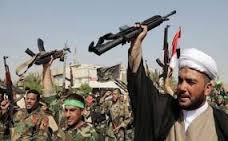

By Heshmat Alavi
Eight months after the “historic” nuclear deal signed with the P5+1, and weeks after “landmark” elections ushering “moderate” into two “elected” bodies of the government, Iran has taken significant steps ramping up its deadly meddling in Syria despite expectations otherwise. Tehran is flexing its military muscles by pumping billions in windfall money to purchase state-of-the-art weaponry for Syrian dictator Bashar Assad. Iran is before our eyes fueling the massacre of now nearly half a million people, as reported by the Guardian, and the displacement of half, yes, half of the Syrian population inside the country and abroad. As the two significant developments failed to alter Iran’s course in Syria, rest assured no other major shifts will be witnessed in Iran under the mullahs’ regime.
Iran was forced to ostensibly accept a very fragile cessation of hostilities agreement in Syria following an agreement spearheaded and sealed between the United States and Russia, and a consensus in the United Nations Security Council. However, Tehran expressed doubts in the cessation success, and wasted no time in adopting an assertive approach to fray the partial cease-fire and deploy even more Revolutionary Guards (IRGC) members and other proxy groups to Syria. Described as an irascible regime, Iran is also hemorrhaging its boots on the grounds in an attempt to dominate all decision making in the Assad regime. Detailed reports show Iran is initiating major attacks in the near future in Syria, especially areas north of Aleppo.
While manifesting its cooperation with the cessation of hostilities as a fait accompli, supreme leader Ali Khamenei, having the last word on all major issues in Iran, has ordered the IRGC to formulate widespread attacks against the Syrian opposition and Free Syrian Army, sources say. One main objective is to take control over the main road linking the cities of Nibil to Aleppo. The IRGC, and hired Afghan mercenaries, have transformed the town of Mayer into a base under their control. These forces are preparing to stage major attacks in the near future, signs indicate.
Concerns are added over reports of further IRGC members being primed and equipped to deploy to Syria. This includes the “Nabi Akram Division” stationed in Kermanshah, western Iran, commanded by Colonel Akbar Nazari, sources say. These units are undergoing intensive training in the city’s Azadi Stadium to send-off at least two battalions to Syria by March 20th. Reports also indicate the IRGC setting up training mine fields inside the stadium.
The terrorist Quds Force, known as the foreign wing of the IRGC, perceived it dire to continue sending to Syria hired mercenaries from various large cities across Iran, sources indicate. At least three planes are taking off each day from the city of Abadan, southwest Iran, and transferring forces directly to Damascus. Around 300 members of the Iraqi “al-Nojba” militia group were transferred to Damascus. Other troubling reports indicate on February 22nd Khamenei ordered the formation of an IRGC ground forces aviation unit to further enhance their deadly attacks in Syria. Helicopter gunships belonging to the IRGC air & space branch are to be allocated to the IRGC ground force.
Enjoying a bonanza of billions of dollars from the nuclear deal, Khamenei is busy purchasing high-tech Russian arms for the IRGC and the Bashar Assad army. A large number of helicopter gunships, warplanes and T-90 main battle tanks are amongst these consignments. This shows that following the nuclear deal Iran, itself fixated on weapons of mass destruction, has pledged to carry a large portion of the bill on arms purchased by Assad from Russia. (Another reason Moscow will continue to block any significant peace effort in Syria).
The roughshod activities adopted by Iran are a clear vindication that change will not come from within. And thus, engagement of any type will not shift policies for the top brass. In fact, it will play into the mullahs’ hands and open the Iran Pandora’s Box. The nuclear agreement and the recent elections, both developments boasted in the West as triumphs for Iran and victories for the pro-rapprochement camp, will render nothing positive for the suffering nations of Iran, nor the entire Middle East for that matter. Anti-Americanism and an anti-West mentality, in general, are pillars of Iran’s official state ideology and quest, not going away any time soon. And for those advocating the “moderate” Hassan Rouhani in Iran, he and those in his camp failed to even mention, let alone criticize the regime’s role Syria in the recent elections. As one columnist put it, Syria is the red line that “reformist,” “moderates,” or “independents” do not dare cross.
“Finally, Iranian politicians across the political spectrum do share the same nationalistic and ethnic objectives when it comes to Iran’s hegemonic ambitions and pursuit of regional pre-eminence and supremacy,” the piece added.
While experts may caution Iran will not change very quickly, recent signs show this regime will not improve for the better at all and has taken long strides and egregious actions in the opposite path headed to nefarious ends.
Heshmat Alavi is a political activist and supporter for regime change in Iran. He writes on Iran and the Middle East. He tweets at @HeshmatAlavi
